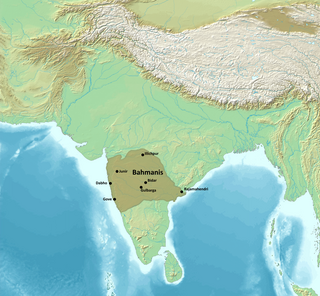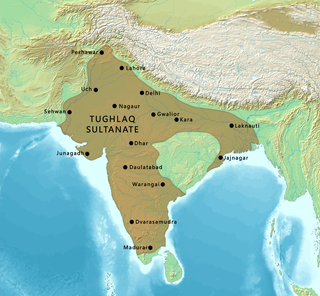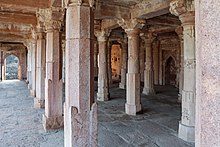
Muslim period in the Indian subcontinent is conventionally said to have started in 712, after the conquest of Sindh and Multan by the Umayyad Caliphate under the military command of Muhammad ibn al-Qasim. It began in the Indian subcontinent in the course of a gradual conquest. The perfunctory rule by the Ghaznavids in Punjab was followed by Ghurids, and Sultan Muhammad of Ghor is generally credited with laying the foundation of Muslim rule in Northern India.

The Delhi Sultanate or the Sultanate of Delhi was a late medieval empire primarily based in Delhi that stretched over large parts of the Indian subcontinent, for 320 years (1206–1526). Following the invasion of South Asia by the Ghurid dynasty, five dynasties ruled over the Delhi Sultanate sequentially: the Mamluk dynasty (1206–1290), the Khalji dynasty (1290–1320), the Tughlaq dynasty (1320–1414), the Sayyid dynasty (1414–1451), and the Lodi dynasty (1451–1526). It covered large swaths of territory in modern-day India, Pakistan, and Bangladesh as well as some parts of southern Nepal.

Sultan Firuz Shah Tughlaq was a Muslim ruler from the Tughlaq dynasty, who reigned over the Sultanate of Delhi from 1351 to 1388. He succeeded his cousin Muhammad bin Tughlaq following the latter's death at Thatta in Sindh, where Muhammad bin Tughlaq had gone in pursuit of Taghi the rebellious Muslim governor of Gujarat. For the first time in the history of the Sultanate, a situation was confronted wherein nobody was ready to accept the reins of power. With much difficulty, the camp followers convinced Firoz to accept the responsibility. In fact, Khwaja Jahan, the Wazir of Muhammad bin Tughlaq had placed a small boy on the throne claiming him to be the son of Muhammad bin Tughlaq, who meekly surrendered afterwards. Due to widespread unrest, his realm was much smaller than Muhammad's. Tughlaq was forced by rebellions to concede virtual independence to Bengal and other provinces. He established Sharia across his realm.
The Sayyid dynasty was the fourth dynasty of the Delhi Sultanate, with four rulers ruling from 1414 to 1451 for 37 years. The first ruler of the dynasty, Khizr Khan, who was the Timurid vassal of Multan, conquered Delhi in 1414, while the rulers proclaimed themselves the Sultans of the Delhi Sultanate under Mubarak Shah, which succeeded the Tughlaq dynasty and ruled the Sultanate until they were displaced by the Lodi dynasty in 1451.

The Bahmani Sultanate was a late medieval empire that ruled the Deccan Plateau in India. The first independent Muslim kingdom of the Deccan, the Bahmani Sultanate came to power in 1347 during the rebellion of Ismail Mukh against Muhammad bin Tughlaq, the Sultan of the Tughlaq dynasty of Delhi. Ismail Mukh then abdicated in favour of Zafar Khan, who would establish the Bahmani Sultanate.

Hoshang Shah (1406–1435) was the first formally appointed Sultan of the Malwa Sultanate of Central India. Also called Hoshang Shah Ghori, he was known as Alp Khan before he took on the title Hoshang Shah after being crowned the ruler of the Malwa Sultanate. Alp Khan's father Dilawar Khan Ghori had belonged to the court of Firuz Shah Tughlaq, the Sultan of Delhi. Dilawar Khan Gori was appointed governor of Malwa probably by Firuz of the house of Tughlaq, but made himself independent of the Delhi Sultanate for all practical purposes in 1401. Thus he had practically come to Mandu in 1401 as the first King of Malwa, although he did not declare himself a king.
Ziauddin Barani was an Indian Muslim political thinker of the Delhi Sultanate located in present-day Northern India during Muhammad bin Tughlaq and Firuz Shah's reign. He was best known for composing the Tarikh-i-Firoz Shahi, a work on medieval India, which covers the period from the reign of Ghiyath al-Din Tughluq to the first six years of the reign of Firoz Shah Tughluq; and the Fatwa-i-Jahandari which promoted a hierarchy among Muslim communities in the Indian subcontinent, although according to M. Athar Ali it was not based on race or even like the caste system, but taking as a model of Sassanid Iran, which promoted an idea of aristocracy through birth and which was claimed by Persians to be "fully in accordance with the main thrust of Islamic thought as it had developed by that time", including in the works of his near-contemporary Ibn Khaldun.

The Tughlaq dynasty was the third dynasty to rule over the Delhi Sultanate in medieval India. Its reign started in 1320 in Delhi when Ghazi Malik assumed the throne under the title of Ghiyath al-Din Tughluq and ended in 1413.
The Muzaffarid dynasty, also called the Muzaffarids, and sometimes, the Ahmedabad dynasty, was an Indian royal family that ruled the Sultanate of Gujarat in western India from 1391 to 1583. The founder of the dynasty was Zafar Khan who was governor of Gujarat under the Delhi Sultanate. When the Sultanate was weakened by the sacking of Delhi by Timur in 1398, and Zafar Khan took the opportunity to establish himself as sultan of an independent Gujarat. His Grand son, Ahmed Shah I established the capital at Ahmedabad. The dynasty ruled for almost 200 years, until the conquest of Gujarat by the Mughal Empire in 1572. The sultanate reached its peak of expansion under Mahmud Begada, reaching east into Malwa and west to the Gulf of Kutch.

Qutb-ud-Din Bahadur Shah, born Bahadur Khan was a sultan of the Muzaffarid dynasty who reigned over the Gujarat Sultanate, a late medieval kingdom in India from 1526 to 1535 and again from 1536 to 1537. He ascended to the throne after competing with his brothers. He expanded his kingdom and made expeditions to help neighbouring kingdoms. In 1532, Gujarat came under attack of the Mughal Emperor Humayun and fell. Bahadur Shah regained the kingdom in 1536 but he was killed by the Portuguese on board a ship when making a deal with them.

The Malwa Sultanate was a late medieval kingdom in the Malwa region, covering the present day Indian states of Madhya Pradesh and south-eastern Rajasthan from 1401 to 1562. It was founded by Dilawar Khan, who following Timur's invasion and the disintegration of the Delhi Sultanate, in 1401, made Malwa an independent realm.

The Gujarat Sultanate or Sultanate of Guzerat was a late medieval Indian kingdom in Western India, primarily in the present-day state of Gujarat. The kingdom was established in 1394 when Muzaffar Shah I, the Governor of Gujarat, declared independence from the Tughlaq dynasty of Delhi.

Ahmad Shah I, born Ahmad Khan, was a ruler of the Muzaffarid dynasty, who reigned over the Gujarat Sultanate from 1411 until his death in 1442. He was the grandson of Sultan Muzaffar Shah, founder of the dynasty.
Malik Maqbul, also referred to as Khan-i-Jahan Maqbul Tilangani and Jahan Khan) was an Indian commander in the Kakatiya Empire who was converted to Islam and rose to become the Wazir of the Delhi Sultanate under Firuz Shah Tughlaq. He was appointed as the governor of Hyderabad in service of the Delhi Sultanate and he ruled and governed all the lands of present day Telangana on behalf of the Delhi Sultanate.
The Farooqi dynasty or the Farooq Shahi was the ruling dynasty of the Khandesh Sultanate from its inception in 1382 till its annexation by the Mughal emperor Akbar in 1601. The founder of the dynasty, Malik Ahmad participated in a rebellion against the Bahmani ruler Muhmmad Shah I in his early years. When he was compelled to flee from Deccan, he established in Thalner on the Tapti River. After receiving the grant of the fiefdoms of Thalner and Karanda from Firuz Shah Tughluq in 1370, he conquered the region around Thalner, which later became known as Khandesh. By 1382, he started ruling independently.
Qāḍī Sayyid Rāfiʿ Muḥammad Dasondhi was a scholar of repute from Sakras, District Gurgaon. He belonged to the family of Gardēzī Sadaat.

Mahmud Khalji (1436–1469), also known as Mahmud Khilji and Ala-ud-Din Mahmud Shah I, was the Sultan of Malwa, in what is now the state of Madhya Pradesh, India. Khilji came into power after assassinating Mohammad, the son of the previous ruler, Hoshang Shah, in 1435. He mounted an unsuccessful campaign against the Delhi Sultanate, however it was under his reign that the Malwa Sultanate reached its greatest height.

Muzaffar Shah I, born Zafar Khan, was the founder of the Muzaffarid dynasty in Medieval India, reigning over the Gujarat Sultanate from 1391 to 1403 and again from 1404 to 1411.
Gujarat, a region in western India, fell under the Delhi Sultanate following repeated expeditions under Alauddin Khalji around the end of the 13th century. He conquered the Kingdom of Gujarat which had been under the rule of the Vaghela dynasty under Karna II and established Muslim rule in Gujarat. Soon the Tughluq dynasty came to power in Delhi whose emperor carried out expeditions to quell rebellion in Gujarat and established their firm control over the region by the end of the century. Following Timur's invasion of Delhi, the Delhi Sultanate weakened considerably so that the last Tughluq governor Zafar Khan declared himself independent in 1407 and formally established the Gujarat Sultanate.












